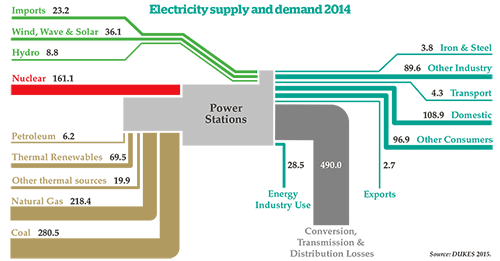NR plans to incorporate Series 1 and Series 2 into its UK Master Series. It will be divided into Category 1a for lines to 140mph, Cat 1b for 125mph and Cat 2 for 110mph. NR plans to make its Master Series suitable to replace older Mk 1 and Mk 3 installations, and to optimise it for tunnels. The first Master Series installation should be the Midland Main Line (now scheduled to be done by 2023 rather than 2020).
With the increase in overhead wiring planned, and the subsequent increase in electric trains, there will be an increase in electricity consumption. In recent years coal-fired power stations have closed and there have been warnings that Britain’s electricity supply situation is becoming parlous. Despite this, in 2013, then Transport Minister Stephen Hammond dismissed concerns that Britain would not have sufficient power for the Government’s ambition to increase electric trains.
Network Rail consumed 3.2TWh of electricity in 2012/13 and expected this to rise to 4.0TWh in 2019, which was the time government expected it to complete its Control Period 5 electrification programme. As a proportion of total UK consumption, NR used 3% in 2012/13, and expects to consume no more than 4.5% when electrification is complete.
Since Hammond spoke in 2013, Britain’s supply situation has slightly eased. In 2014 regulator OFGEM said that it expected generating margins to fall to their lowest level in 2015/16, as supply from conventional sources (such as coal) reduced. In 2015, OFGEM reported a reduced risk for 2015/16, following mitigation efforts from National Grid, and said it expected further reductions in 2017/18 as more capacity came on stream.
OFGEM futher noted that the average cold spell (ACS) peak demand was falling. It was 60GW in 2005/06, 54GW in 2013/14, and is expected to be 52GW in 2017. It predicted that conventional capacity would rise to roughly 75GW when all installed capacity was included.
Yet in a report released in late January (Engineering the UK Electricity Gap), the IMechE warned of a power gap. It suggested this gap could be around 50%, with the closure of coal power stations and insufficient time to build suitable replacements. It also cast doubt on government proposals to build more gas power stations, noting that it would need a considerable increase in building compared with recent years. This was followed by news of possible further delay in building EDF’s nuclear power station at Hinkley Point C.
The Government’s Digest of United Kingdom Energy Statistics 2015 (DUKES 2015) reports falling consumption from transport. Currently, 96% of UK electricity consumption for transport comes from rail, with NR and London Underground the major users). But in recent years consumption has been falling (see table), to give a 2014 figure of 4.2TWh. Predictions from the Department of Energy and Climate Change (DECC) suggest that by 2019, transport electricity consumption will reach 5.1TWh. (For context, in 2014 domestic consumers used 109TWh while 490TWh was wasted in conversion, transmission and distribution losses, according to DUKES - see diagram.)
In early 2013, NR announced that it had signed a ten-year deal with EDF Energy for electricity, to be supplied by EDF’s eight nuclear power stations. This, said NR, assured its supply of low-carbon electricity. Overall in 2014, nuclear power stations contributed 161.1TWh, with EDF’s eight stations bringing a total capacity of 8.9GW (see table below).
NR’s 2012/13 figure of 3.2TWh represents 76% of that year’s 4.2TWh rail consumption. Its 2019 (post-electrification) figure of 4.0TWh represents 78% of DECC’s transport consumption prediction. This suggests that NR’s increased consumption remains roughly in line with government predictions, which themselves are within OFGEM’s assumptions for future capacity.
From this perspective, there is nothing to stop NR forging ahead with electrification. With manufacturers offering trains with better energy efficiency (from such techniques as regenerative braking), there’s every reason to convert from diesel to electric.
The large blot on the landscape is the massive increase in capital costs, which has severely damaged the railway’s credibility, but fortunately ministers are happy to look the other way in the face of rising bills. Perhaps, when we have an electric railway equivalent to Switzerland’s, we’ll thank them.
Read the peer reviews for this feature.
Download the graphs for this feature.












